
Garmin’s newest heart rate strap is one designed specifically for women, which essentially takes the features of Garmin’s high-end HRM-PRO Plus, but molds it into a strap that snaps onto your existing sports bra. The design aims to increase comfort compared to traditional chest strap bands (which go all the way around the chest and tend to be restricting), while still maintaining chest-strap accuracy.
Given the unit’s lineage with existing Garmin HRM-PRO series straps, that means it maintains features like advanced running metrics, offline data caching, indoor run/treadmill running pace data transmission, as well as tracking steps/calories/intensity minutes even when a watch isn’t worn. However, all of this comes at a significant price bump, bringing the price to an eye-watering $149USD.
Now, this is one of the few products I can’t actually test directly. So instead, my Ironman triathlete wife has been putting it through its paces, as well as another (female) family friend, thus providing multiple viewpoints on the HRM-FIT. This includes both comfort/fit thoughts, as well as data accuracy notables. While it may seem like it should work just like the HRM-PRO series in terms of accuracy, one of the chief components here is ensuring a snug fit so that it doesn’t move around (which would reduce accuracy).
So with that, let’s dive into it.
In the Box:
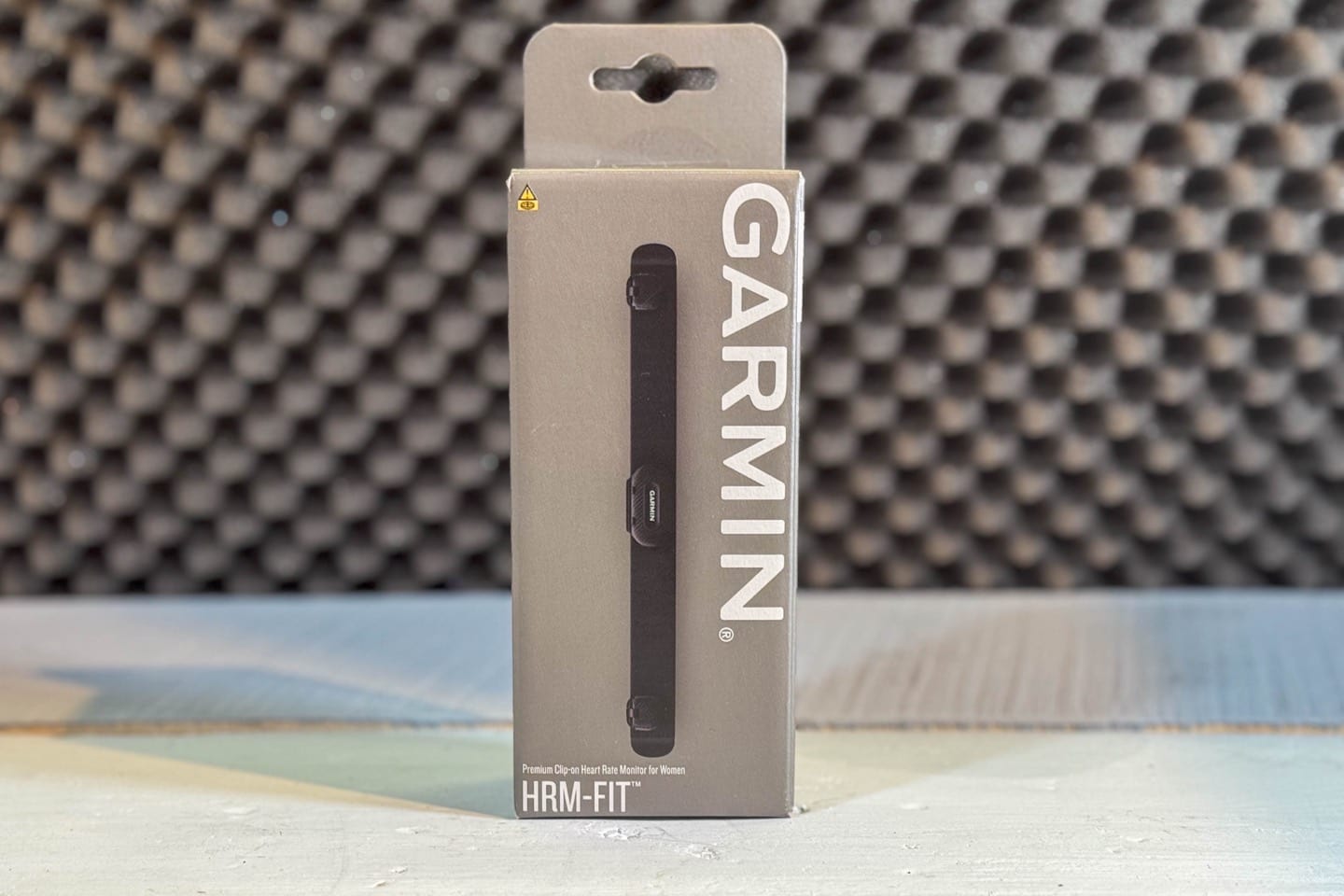
This section will not take long, it’s very efficient. Above is the box, below is what’s inside the box. You’ve got the strap itself in some paper, a quick start user guide of sorts, and then a warning sheet with the usual disclaimers.

Here’s what happens when you free the HRM-FIT of its paper wrapper:
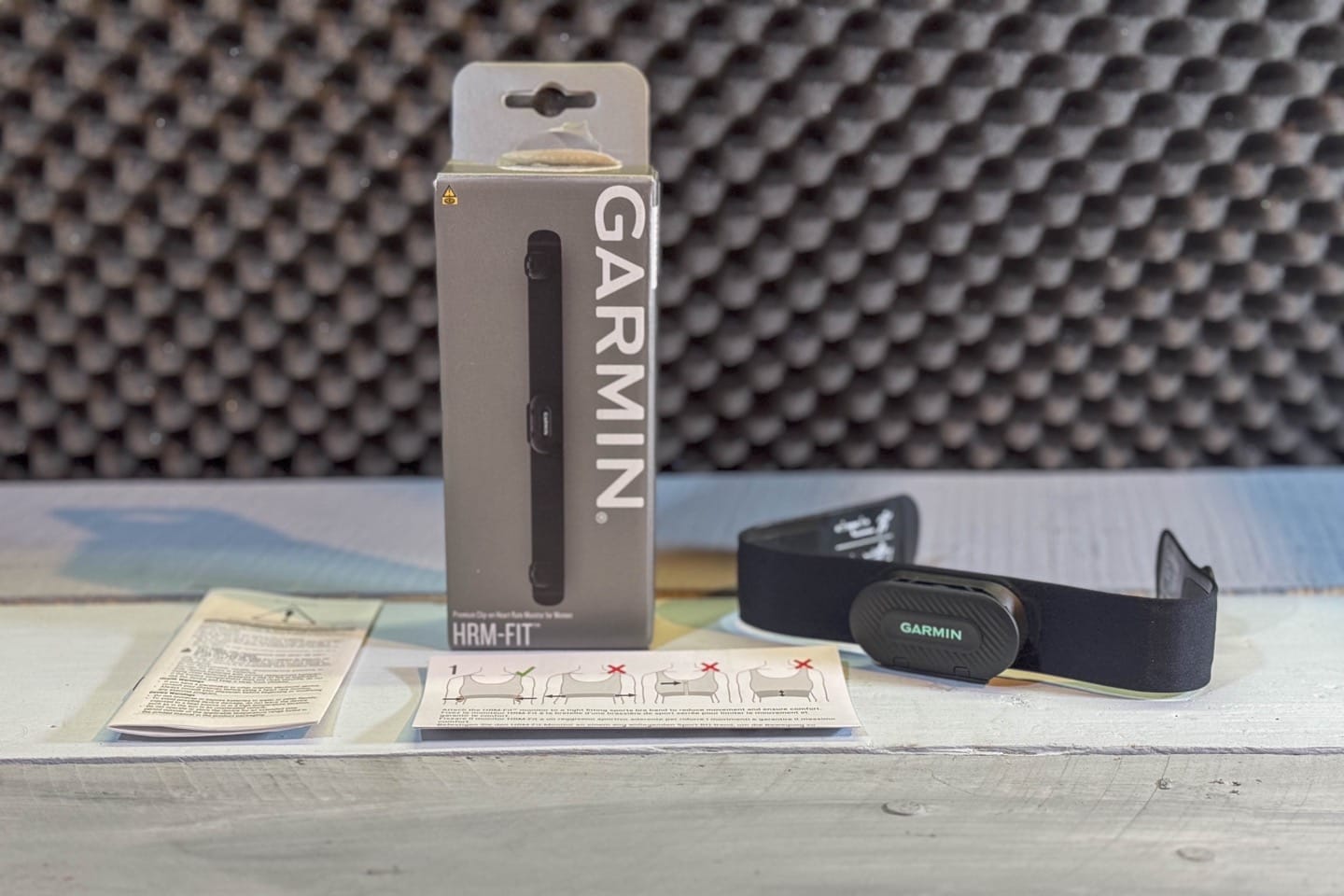
And then here’s a closer look at the strap on the front right:

Followed by front left:

And then the inside/back of the strap, where the actual sensors are:
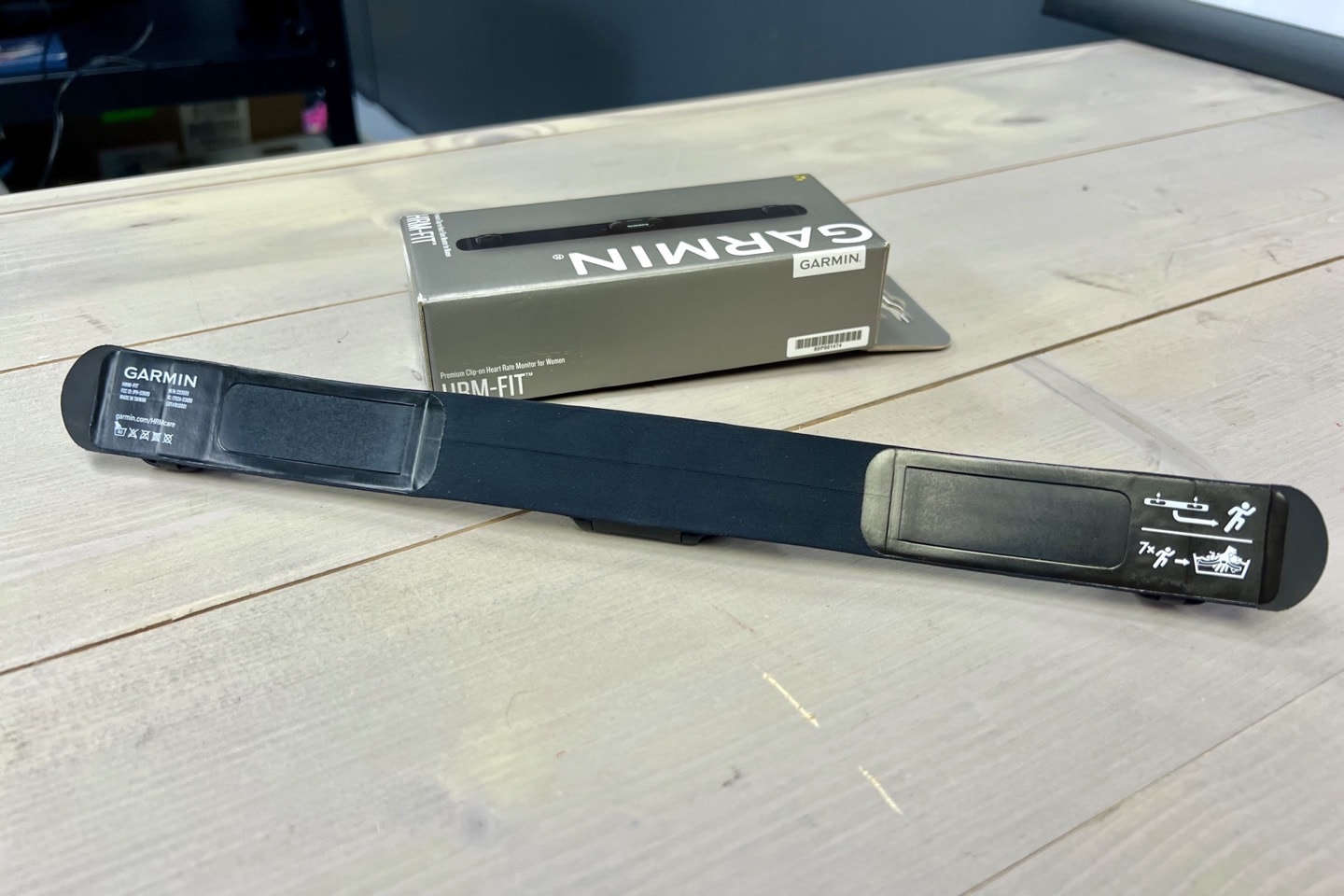
For comparison on weight, the HRM-FIT weighs 54g, while the HRM-PRO Plus weighs 53g.
So let’s get it fitted and start working out.
Setup & Fit:

The first order of business is getting the strap connected to your existing sports bra. Garmin states (rather specifically) that this should primarily be used on medium and high-support sports bras. This is mainly to ensure that things stay put, namely with the strap. For those not versed in sports bra support, low-support sports bras are more ideal for low-impact activities like yoga, whereas the more you move, the more support you tend to want/need. Thus moving up to medium and high-support sports bras.
In the same way that the goal of a sports bra is generally to minimize movement of your chest, that’s also true for the HRM-FIT too. With heart rate monitors, movement is bad (be it chest straps or optical sensors/bands). When things move, algorithms might mistake that movement for a different heart rate level.
That said, first up is actually snapping it onto the sports bra. There are three snaps on the HRM-FIT to accomplish that: Two outer ones, and then a center one over the pod. The strap itself is actually up against your skin, whereas the snaps are on the outer layer. Here’s a close look at those snaps:

These clips then snap onto the sports bra, rather snugly using small teeth. These don’t appear enough to rip the fabric, unless you try and rip the strap off your chest Justin Timberlake style…but to each their own.

In watching both my wife and our friend try installing these for the first time, there’s a little bit of play in ensuring that the length of the HRM-FIT is taut/snug along the sports bra. In other words, you don’t want rippling or such in the HRM-FIT, as then it won’t be accurate.

I’d recommend doing the installation with the sports bra on yourself, rather than trying to install it before you put it on. This is because the sports bra will stretch as you put it on, and thus if you install the HRM-FIT prior to that, it’ll likely be all wonky.

Closing up the snaps is simply shutting each one, quick and easy at that point.

Easy peasy, done:

Now, before we get into data connectivity bits, just a quick note about the battery compartment. The design here follows a simple coin-cell battery compartment that can be unlocked with a coin or flat-blade screwdriver (or…a butter knife):
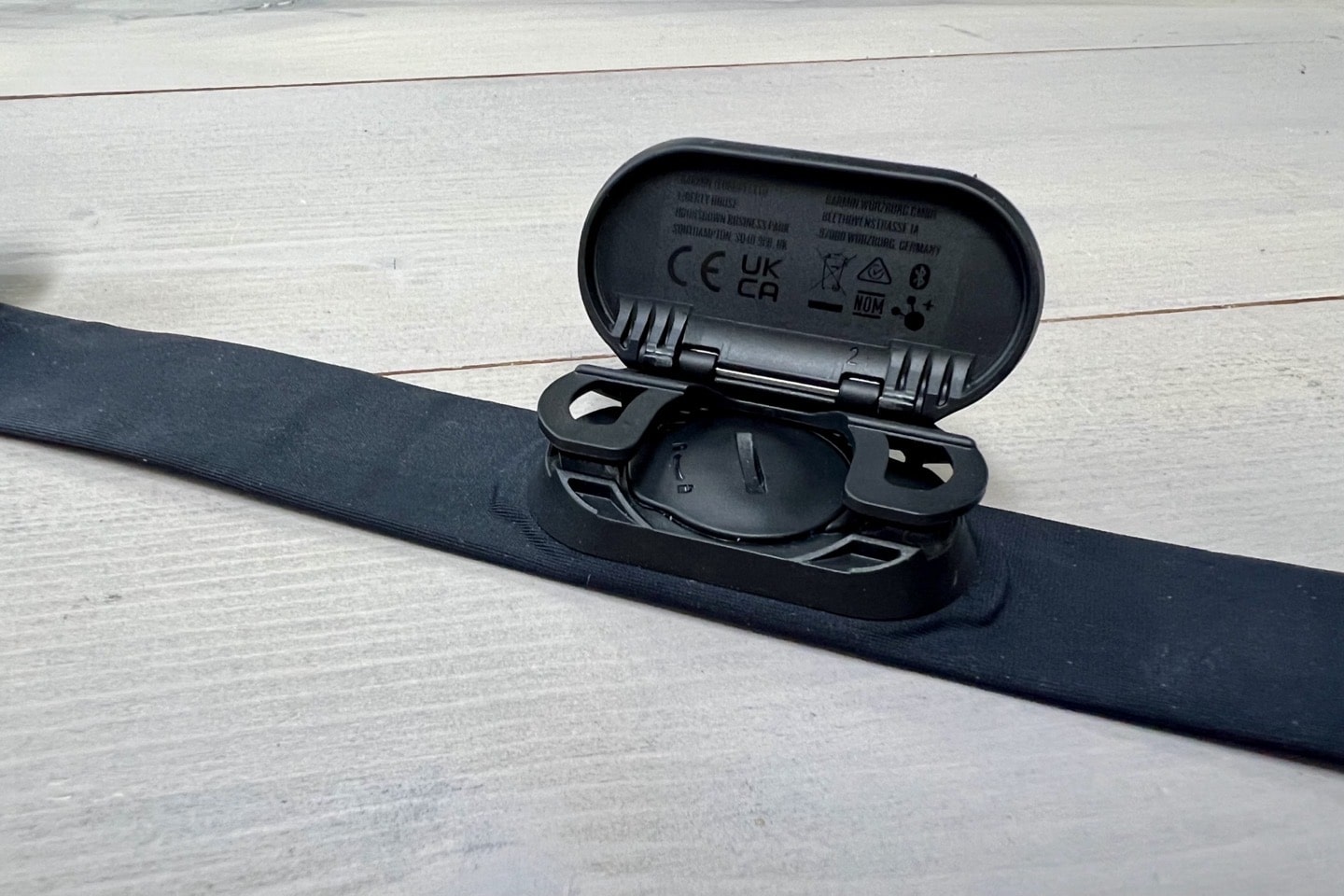
Garmin claims about a year of battery life. Notably though this is actually the first time we’ve seen this specific design on a Garmin heart rate strap.
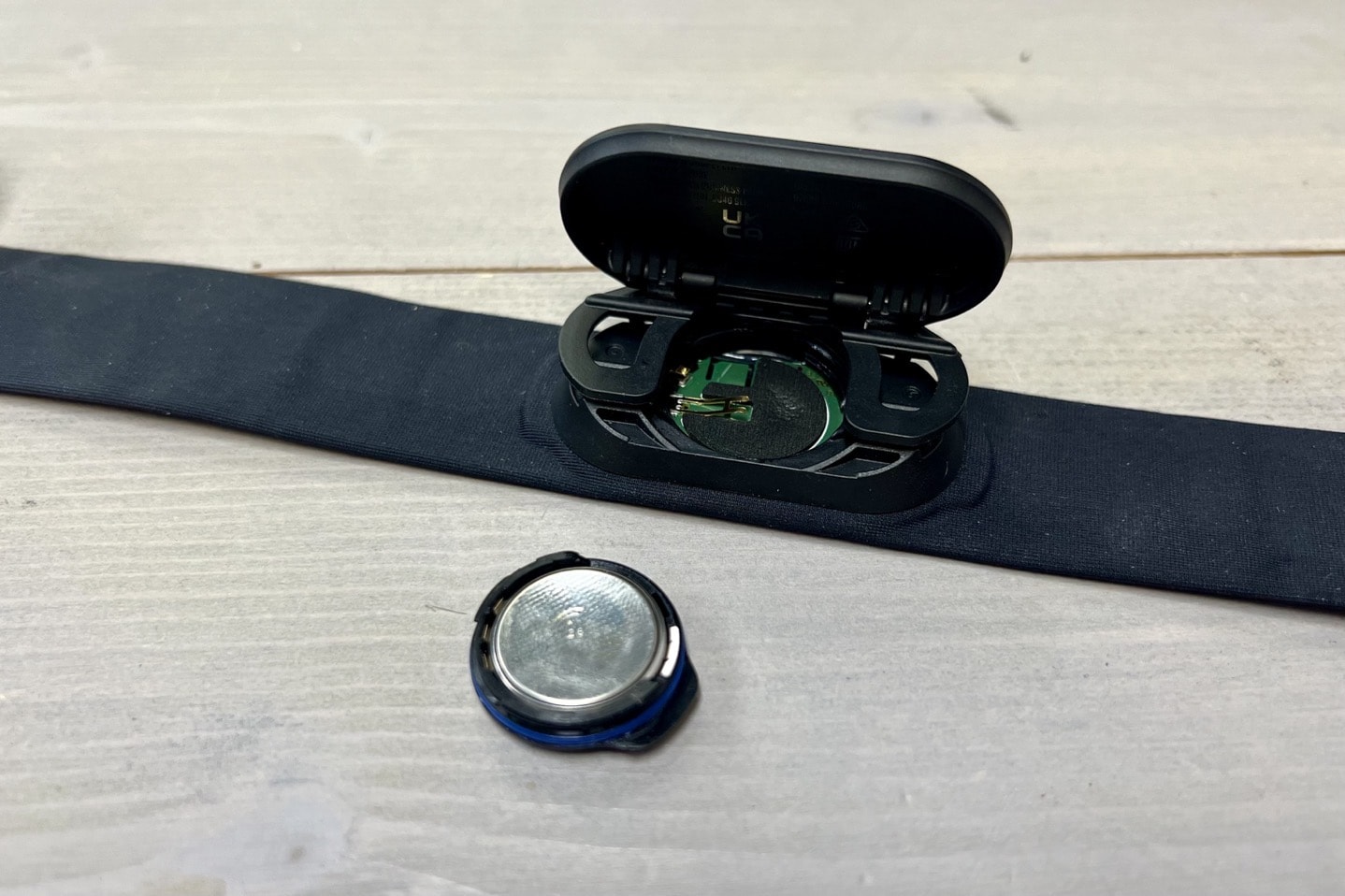
Prior to the HRM-PRO Plus, they used screws for their straps, which led to higher failure rates when they weren’t absolutely perfectly put back in place. Then with the HRM-PRO Plus in 2022, they switched to a design sorta like the HRM-FIT design above, but with a wider turning portion, seen below:
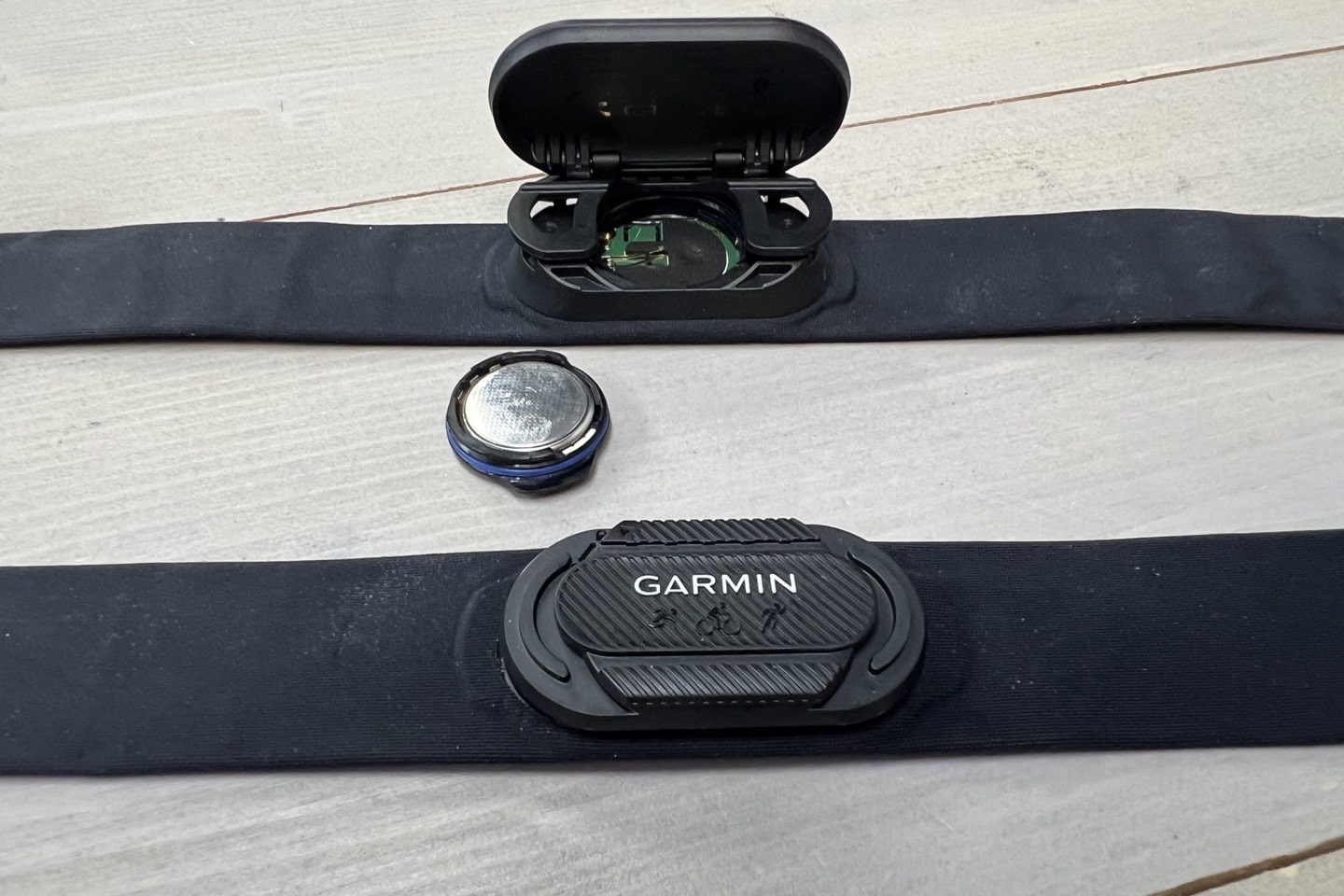
Garmin says all of these designs are suited for water immersion during a triathlon/swimming.
Usage and Test Feedback:

The first thing to know about the HRM-FIT is that, yes, it’s got the foundations of a regular chest strap in terms of connectivity. That means it’s going to transmit on both ANT+ & Bluetooth Smart, just like a $50-$70 strap. But beyond that, it’s got all the fancy features seen on other higher-end Garmin chest straps too. We’ll talk about all those in a second.
To pair it to any Garmin watch or app, you’ll search in the sensors menu for sensors. If on a Garmin watch, like this Forerunner 965, you’ll see it listed under the sensors pairing menu, as a chest strap:
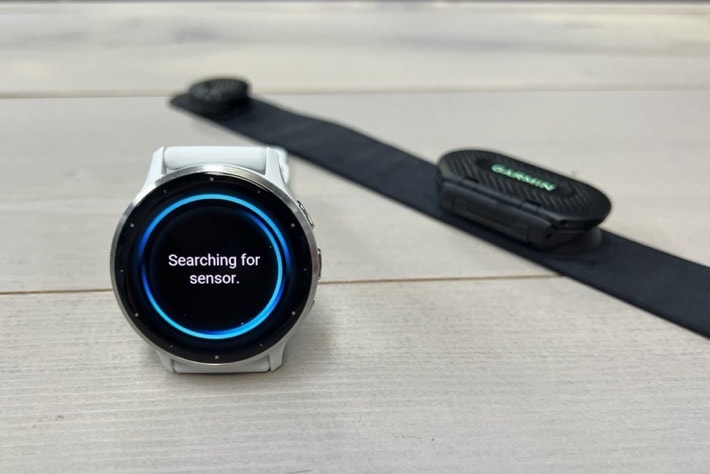
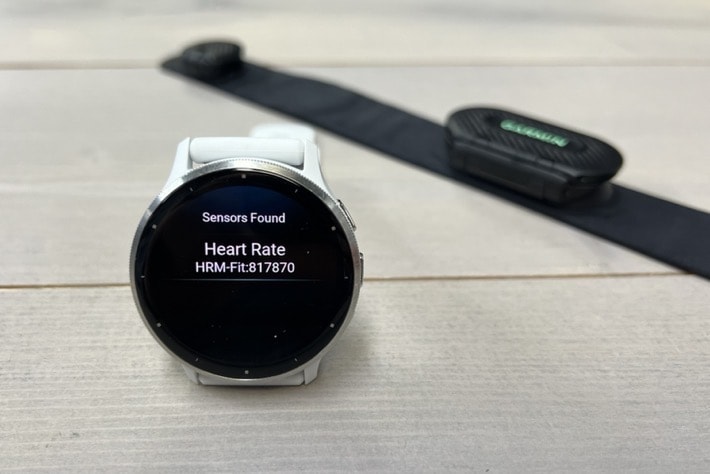
Whereas for an app like Strava, you’ll see it listed in the Strava sensors menu:
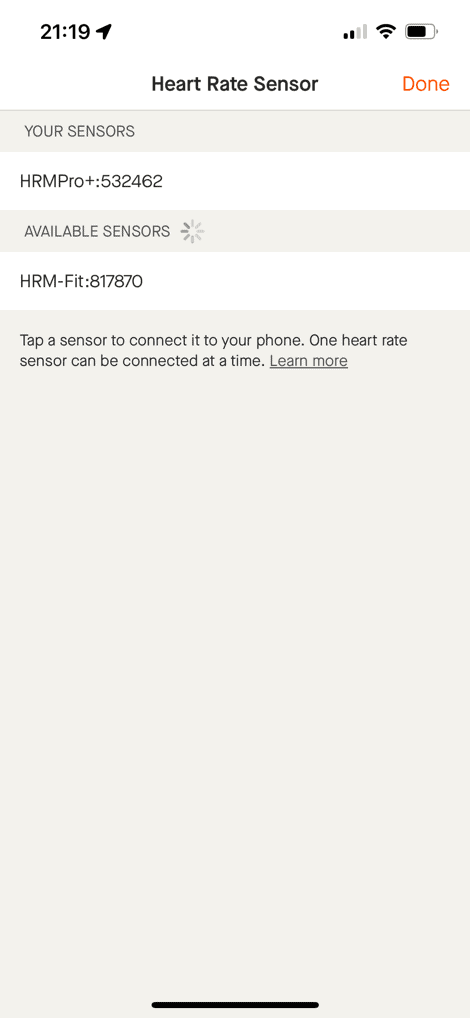
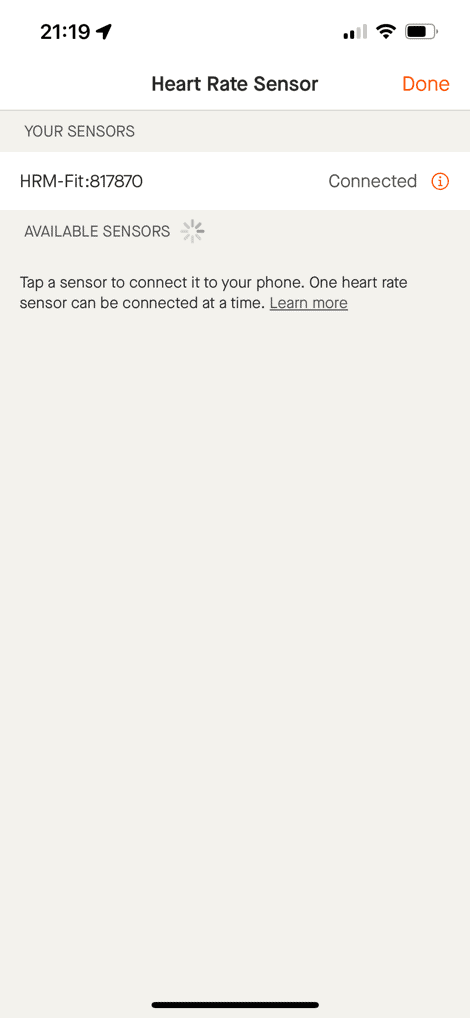
And for something like a Peloton Bike/Treadmill/App, you’ll see it listed there too when you tap to search for heart rate monitors:
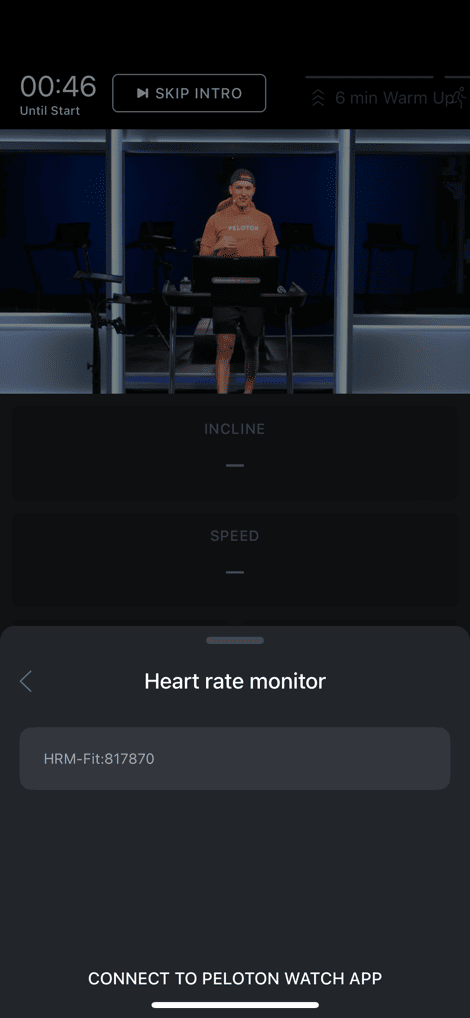
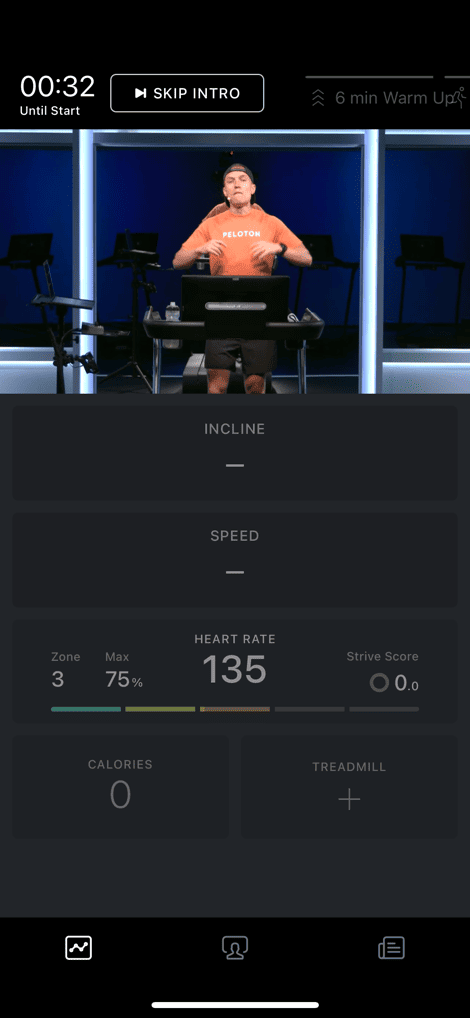
Then, once paired, you’ll see your heart rate on the device/app. Heart rate zones aren’t defined on the HRM-FIT specifically, but rather by whatever app/device you’re using. The HRM-FIT itself is unaware of any zones you have, it’s just focused on sending the base heart rate value (BPM), plus a bunch of other metrics we’ll talk about in two seconds.
All of this data is, of course, available on the watch/app in real-time, and then depending on which device/platform/app you’re using, you can see it afterwards recorded. For example, on a Garmin watch, you can see the heart rate data, like shown here:

So, tech bits aside, the main benefit of this strap is that it’s less restrictive feeling than a traditional chest strap. A few minutes into my wife’s first run, I asked her what she thought about it. Her initial thoughts were that it felt like it was going to fall-off, but of course, she noted that was purely a mental thing – since clearly it wasn’t going anywhere. She continued that the feeling was largely because when she normally wears a chest strap, she puts it on pretty tight, so that there’s no movement/sliding. By the end of her workout, including a slate of high-speed/high-intensity intervals…the strap had gone exactly nowhere.

Post-run, what’d she think about it? By the end of the run, she no longer had the feeling that it was going to fall off, as she got used to it. But, she pointed out that you definitely do need a snug-fitting sports bra (which mirrors what Garmin also recommends).
Now, fast forward a few more rides/runs later, what are her thoughts on it, as compared to a traditional strap? While she’s gotten used to wearing it, she’s a bit perplexed as to the point of the product. From a female perspective, she noted it doesn’t really seem to solve any of her main chest strap problems. She said that while it gets rid of the constricting feeling of a chest strap, the reality is that your sports bra will almost always be equally, if not more, constricting compared to the band of a chest strap. Secondly, while she didn’t get any chafing on it (like she sometimes does on other chest straps), it wasn’t quite hot enough with long enough workouts when she usually gets that anyway (summer, 2hr+ runs). Next, she noted the extra bumps of the design will stick-out through thin shirts, or even just be these odd extra bits if only wearing a sports bra itself. Finally, she found the act of snapping it on kinda fiddly, but more than anything, trying to unsnap the clasps was a recipe for breaking nails.
In summary, she doesn’t have anything against it, but just doesn’t see why she’d spend 50% more for the extra hassle with no obvious benefit for her. She noted that maybe someone else is trying to solve a different problem that it somehow addresses though.
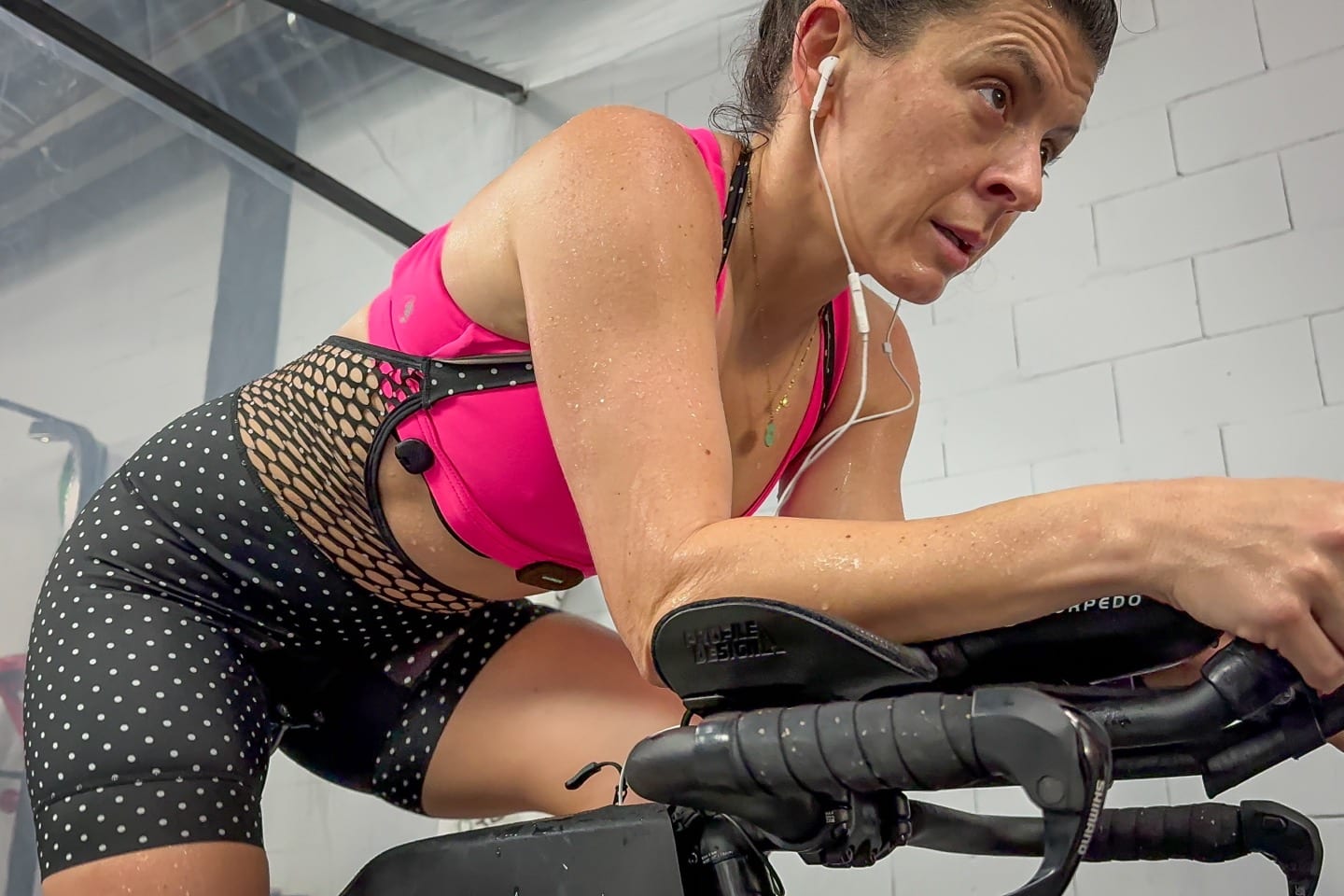
Next, we’ve got a friend who is a runner (road/trail), that also does Peloton Bike workouts. She used it for a treadmill workout, including some higher-intensity sections:
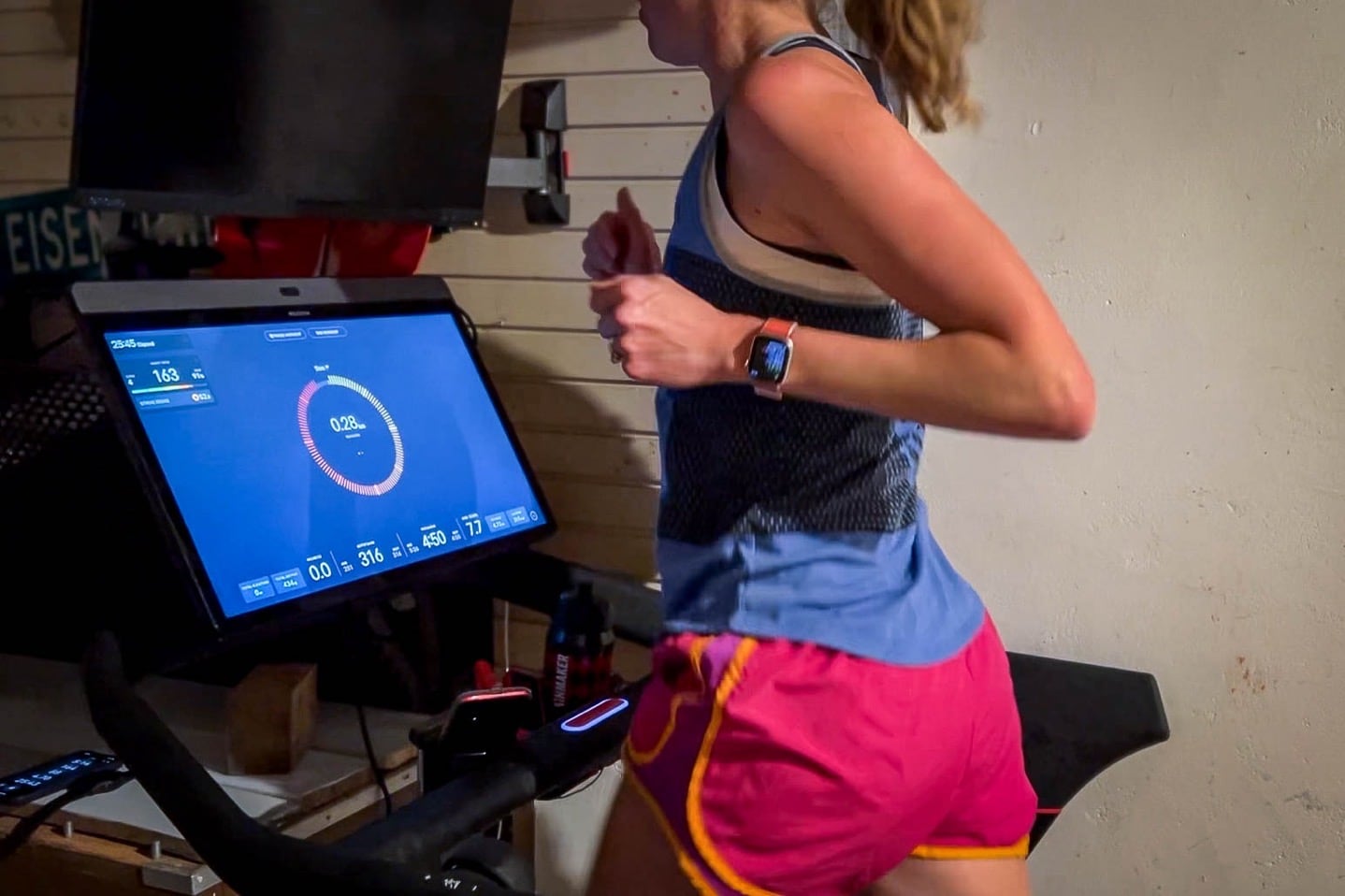
She wore it for fewer workouts, and we made a point to not provide any opinions positive or negative about it, till she gave her thoughts. She said: “That was kinda annoying to wear though. The one on my arm [Polar Verity Sense], seemed a lot better.” Continued discussion roughly mirrored that of my wife, she just didn’t see what it added to the picture. She normally wears an Apple Watch, though has certainly worn chest straps here and there in the past. But for her, she was much more inclined to look at an optical armband HR sensor than either the HRM-FIT or other chest strap.
From my (non-female) perspective, but one who hears a TON of feedback daily from boatloads of runners, I’d tend to agree with both of these opinions. I struggle a bit to see who this is targeting. The (maybe) singular area I can see over a traditional chest strap is potentially minimizing the chance it’ll slide down your chest, but I don’t hear that comment/concern frequently.
In asking Garmin about who the target market is, as well as the feedback they had received in terms of added bulk to the sports bra via the whole clip/etc system, they said (I also asked about the women on the patent, more on that in a second):
“The HRM-Fit is designed for most body sizes and shapes. We had several hundred testers ranging from 32-42 chest size and AA-G bust size. The feedback we received was more related to a good bra fit and not body size, that’s why we recommend wearing a medium- and high-support sport bra to maximize comfort. Of the women on the patent, we also range in size, shape, and types of activities we do. While we believe the HRM-Fit currently is an improved experience for women, similar to our other products, we’re always looking to engineer a more streamlined, minimal design for future iteration, which for this product includes smaller strap length and clip profile.”
Now, you’ll see Garmin referenced the women on the patent. One notable item here is that Garmin actually filed a patent for this unique design some while back. News of it was picked up by various rumor/leak sites. In that patent, five out of six of the Garmin individuals named are actually women. That’s what Garmin is referencing above. Still, it’s cool to see, and also referenced above are ways they could perhaps make the product more minimalist in the future.
Advanced Metrics & Data:
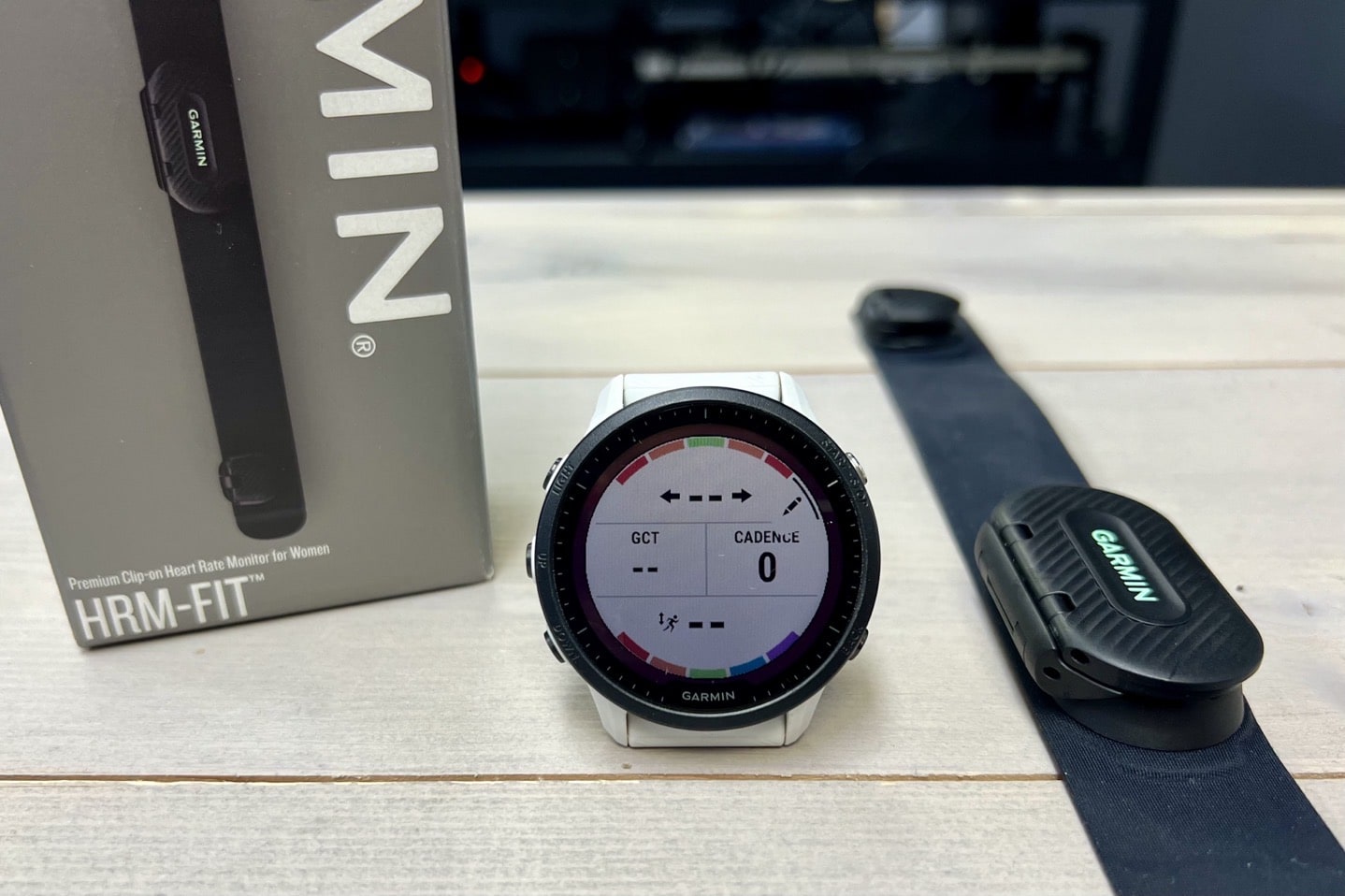
At this juncture, if you don’t need/care about the fanciness of the HRM-FIT connecting to the sports bra in a more comfortable way, then obviously, you can spend considerably less for the exact same Garmin features (e.g. HRM-PRO Plus, usually around $100), or, even less for just a general chest strap from Garmin, Polar, and others (usually around $50-$70).
The Garmin HRM-FIT supports 3 concurrent Bluetooth connections, and unlimited ANT+ connections. Generally speaking, it’s best to connect the HRM-FIT via ANT+ if connecting to a Garmin device, since it’ll support more advanced data that isn’t shown when connecting via Bluetooth.
Now, from a data standpoint, the bulk of the fancier features on the HRM-FIT (like the HRM-PRO series before it), are extended data metrics. Specifically, the following items, which are basically only useful for Garmin watch users:
– Garmin Running Dynamics data transmission (with compatible Garmin watches)
– Indoor pace/distance when paired (with compatible Garmin watches)
– Garmin Running power using Connect IQ app (older watches), or native integration on most of Garmin’s 2022-2024 watches
– Cross Country (XC) Skiing Power Support as of October 2020, only available in the HRM-PRO/HRM-PRO Plus
– Offline workout support for swimming (or really any other sport) with a compatible Garmin watch
– Capturing of Intensity, Steps, Calories, and Heart Rate when watch isn’t worn (via smartphone app)
– You’ll see battery status of the strap within your Garmin Connect workout summary data (right side on website for each activity)
– Concurrent Bluetooth & ANT+ Connectivity (with three Bluetooth connections, and unlimited ANT+ connections)
The general trend of what you see there is that these are extra features with extra data that largely only work with Garmin watches. However, some of those features no longer require a chest strap to work. For example, running power on newer Garmin watches no longer requires a chest strap like it used to. Older ones do still require it though, where this could be useful. Similarly, most of the Running Dynamics metrics no longer require a strap either – those too are calculated internally to the watch now.
But features like offline caching of workouts (if you don’t wear a watch), or calculating steps/calories/intensity minutes are still valuable – but again, do require a Garmin watch. You can’t simply download full workouts from the HRM-FIT to your phone and then up to Strava. You’ll need a watch to sync those full workouts from HRM-FIT to watch, then to Strava.
Taking a quick look at what those advanced Running Dynamics metrics look like, you can see them both on your watch (Garmin watches only) as well as afterwards on Garmin Connect, such as these:
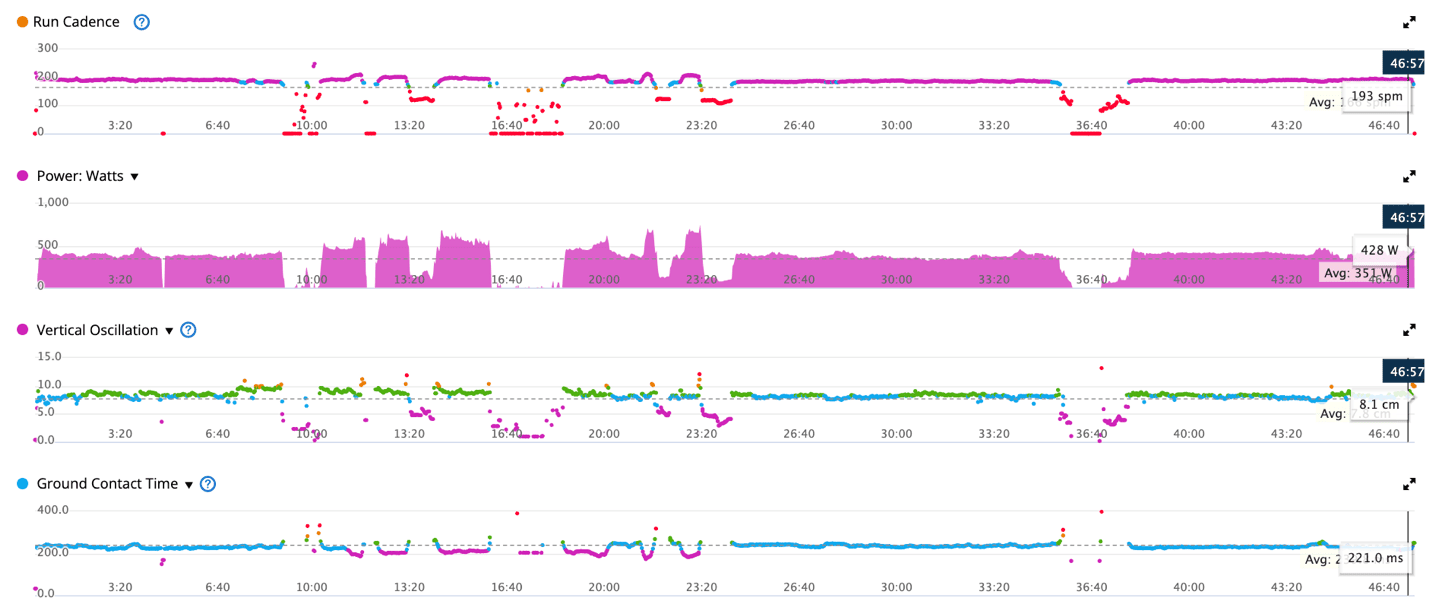
Both the above/below charts were collected from the HRM-FIT during one of my wife’s runs, connected to a Garmin Forerunner 955.
And here’s a bit further down with more summary data:
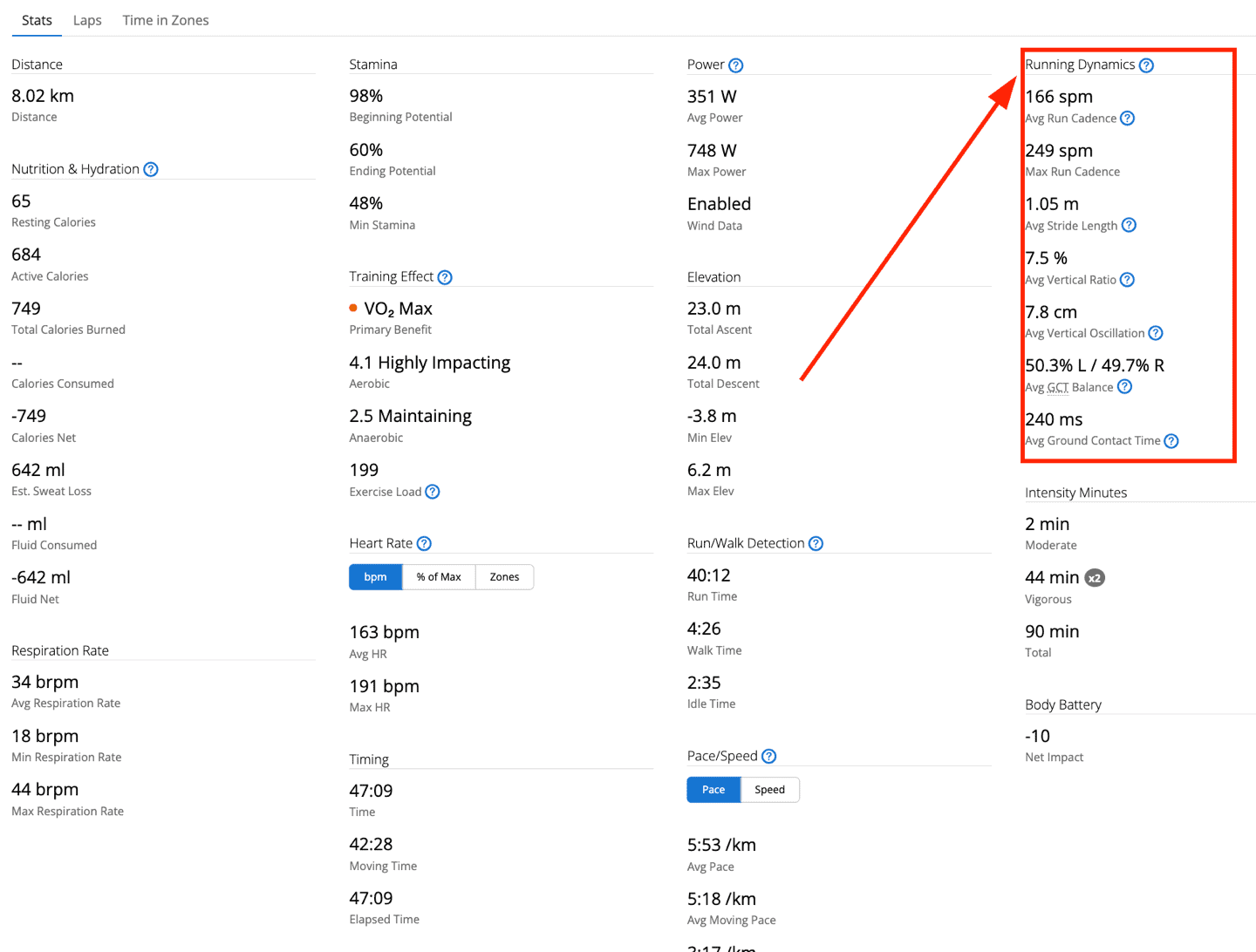
Again, keep in mind that most of Garmin’s 2022-2024 watches now support these without the need of a strap; thus this is really more valuable for older Garmin watches.
Whether or not you find value in the Running Dynamics metrics is up to you. Personally, I don’t find much value there at this point. It has been on the scene for years, and I’m still not super clear on what to do with the data. My coach does find some value in a handful of the metrics in terms of seeing some impacts of fatigue in longer runs. Note that the definition of Running Dynamics metrics, in this case, is specifically Stride Length, Vertical Ratio, Ground Contact Time, Ground Contact Time Balance, and Vertical Oscillation. Note that the Vertical Oscillation/Ratio chart has a toggle, as does the Ground Contact Time/Balance chart.

While the strap also includes the cadence data, that actually comes from your watch anyway (or a footpod, if you have one of those). So, while Garmin sometimes groups that under the Running Dynamics banner in marketing blurbs over the years, that’s not actually the case and is recorded already on every Garmin wearable.
Next, you’ll see Running Power data. However again, that depends on which watch you have, and most newer Garmin watches just do it without the need for a strap. Still, if you’ve got an older Garmin watch (e.g., a Fenix 6 or Forerunner 945), then this is certainly useful. The end-state chart is very similar no matter which watch you have, so for the moment here’s an example with a Forerunner 955:

Next, there’s the ability to get pace/distance data from the strap, mainly for treadmill running (or any other indoor run), though it can also be used outdoors if you really wanted to. By default, Garmin watches will leverage the data just for indoor run workouts (non-GPS), but you can toggle that in the watch settings if you want:

This tends to lead to more accurate pace/distance data indoors, compared to some wrist-based estimations. Here’s an example of the indoor pace/distance data from a run yesterday my wife did on the treadmill, where the watch was sitting on the treadmill, but connected to the HRM-FIT as the singular source of pace/distance/cadence/heart rate/etc:
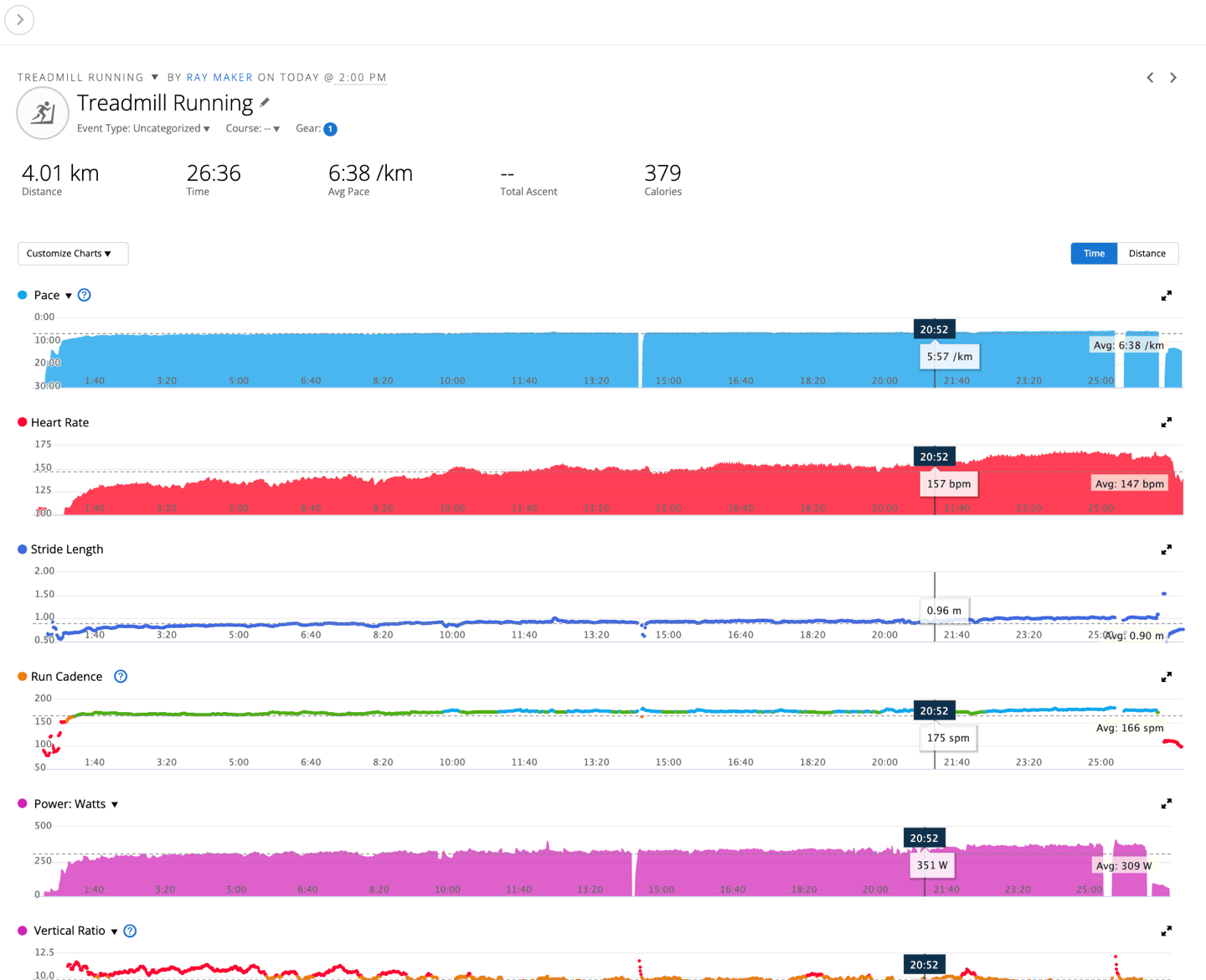
Finally, when used in conjunction with a Garmin watch, you can record workout heart rate data to offload after the workout is complete. This is useful when swimming (since digital transmissions can’t penetrate more than a few centimeters through water), or in sports like football/soccer or others that don’t permit a watch to be worn. In those cases, the usage is the same: Start the sport with the strap paired, and then go do the sport. If it’s swimming, obviously wear your watch. If it’s football, just leave the watch in a bag, recording. Once done, save the activity on the watch. It’ll ask if you’d like to download that heart rate data from the strap:


Note that most recent Garmin watches do record heart rate data during a swim, however the accuracy of optical heart rate data during a swim is hit or miss (from any vendor), due to the fact that water sits in between your wrist and the sensor, making it iffy at best. So this helps to sidestep that.
The download process usually takes 5-10 seconds to complete, and if it can’t see/find the strap for some reason, it’ll ask if you want to search again (perhaps you took off the strap and forgot, so it went into standby – or perhaps the strap is still underwater). Once done, it’ll merge the data sets together, and you can get the full and clean data from the strap, as opposed to the watch’s wrist data.
And again, this offloading capability is only applicable when triggered by a Garmin watch, and isn’t something you can just do with the Garmin Connect Mobile app (or 3rd party apps).
Accuracy:

In this section, for almost all heart rate sensors I do testing of, I typically compare it against a chest strap (usually multiple straps from multiple vendors over multiple workouts). Further, I use optical HR sensors (usually upper arm bands) as well as various watches (usually well-known good ones).
But, with chest straps it tends to get a little bit trickier, due to having two straps. Still, even with chest straps I can usually pretty easily wear two straps – one on the upper chest and one on the lower chest. But me doing that as a male is pretty easy. It’s virtually impossible for most women.
Thus in the case of the HRM-FIT, I used a blend of upper arm optical heart rate sensors (including the best one, the Polar Verity Sense), then each person was fitted with one or two watches, thus giving me at least three comparative sensors each time.
First up, let’s start with an indoor cycling workout, which should be relatively straightforward, as it lacks much in the way of bounce/movement. Here’s that data (the HRM-FIT) compared to the Polar Verity Sense (optical band), and Garmin Fenix 7S Pro (wrist optical HR sensor):

Here you can see it’s virtually identical to the other sensors. Even through some high-intensity intervals, it tracks well, without issue. In this case, it’s worn on a lower-support sports bra, because she’s on the bike without any meaningful movement. There’s no reason to belabor this particular set any further, it’s perfect.
Next, let’s shift to an indoor treadmill run. This was done in the heat acclimation chamber, albeit not in full blowtorch mode, so while it was warm/sweaty, it wasn’t crazy dripping sweat. Here’s that compared to the Polar Verity Sense, Garmin Fenix 7S Pro, and Garmin Lily 2:
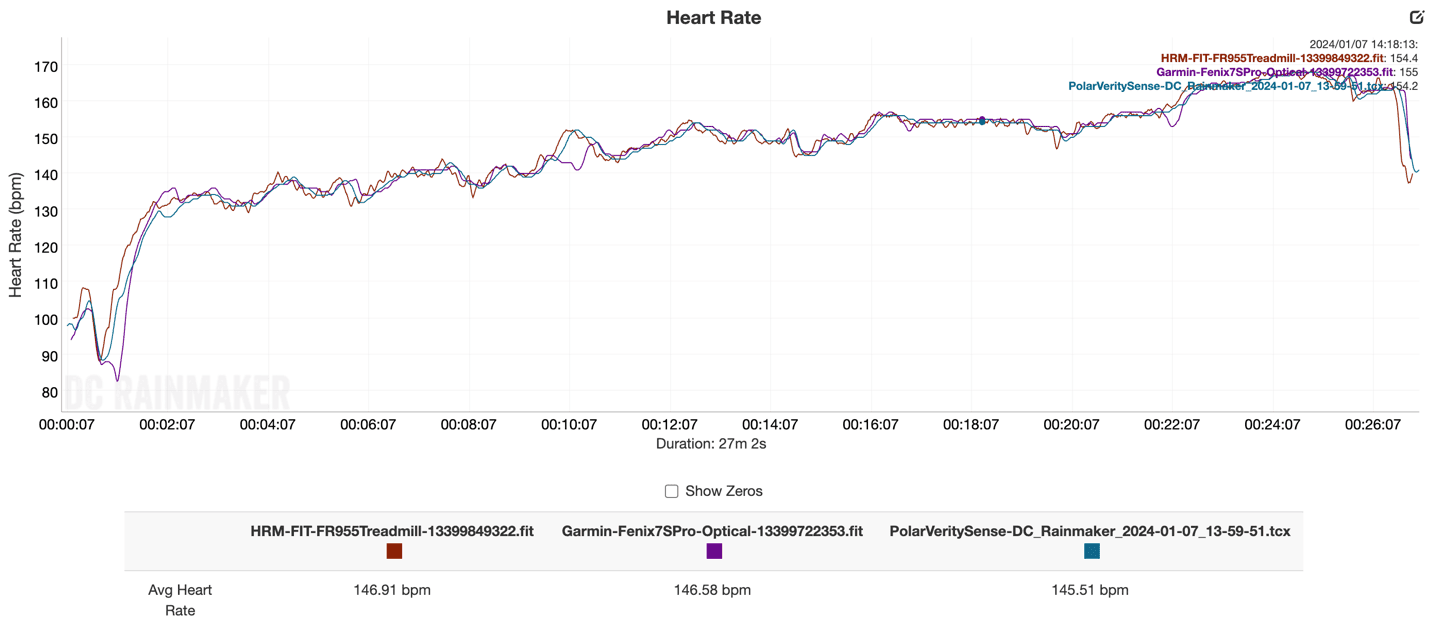
Here we see pretty solid agreement as well, without any real issues. As always, you’re going to see slight differences/delays between different straps, but these are essentially a wash across the board.
Next, let’s head outside. This time, it was cold AF, just a degree or two above freezing. About the first half of my wife’s run was with just the sports bra, and the other half with a light running shirt over it. That’s compared to the Garmin Fenix 7S Pro and Garmin Lily 2 (sadly the Polar Verity Sense battery had somehow been left on overnight), here’s the data:
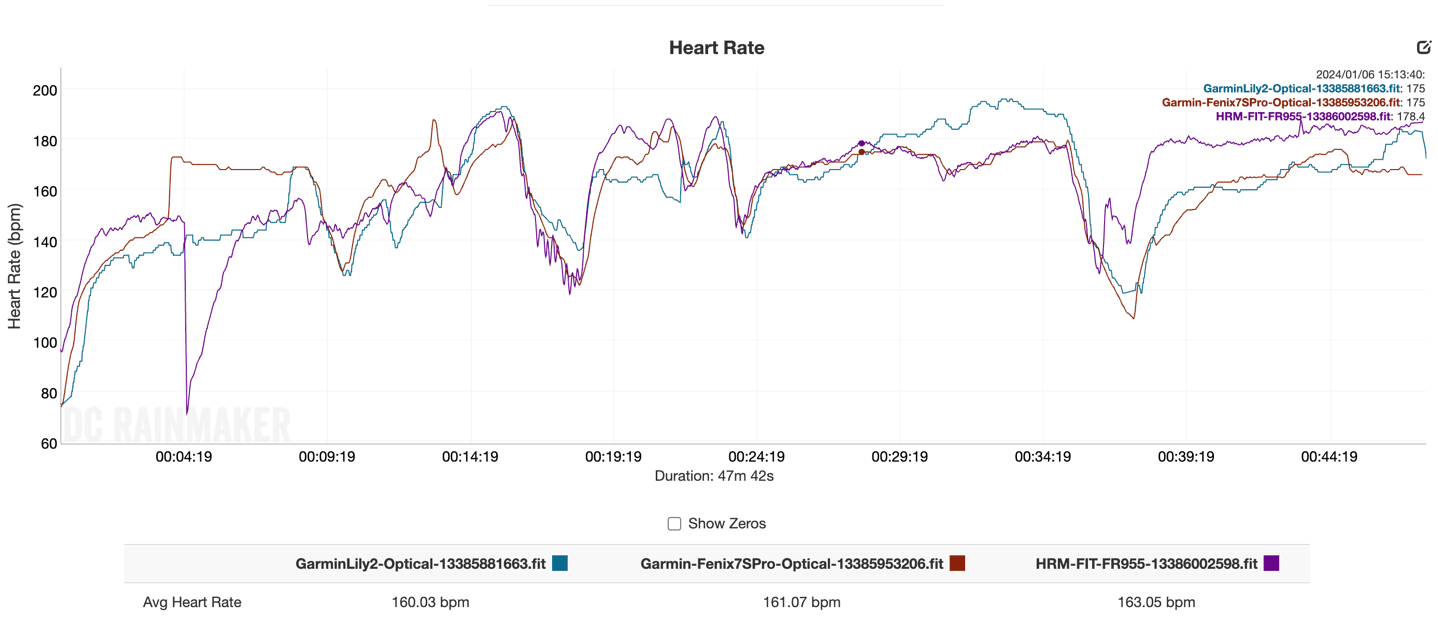
Well then, that’s a proper mess. You can see, certainly in the first half, everyone is having issues across the board. You can suss out that the HRM-FIT is slightly more stable in that dumpster fire, but only just barely. However, once she adds the warmer clothing, things settle down for the second half of the run.
This actually makes perfect sense, and is exactly what you’d expect to see on any chest strap from any company in very cool/dry weather without much sweat/moisture production going on. These paces weren’t hard enough in warm enough weather to have my wife sweat at all, thus the strap quickly dried out, resulting in issues.
Next, in order to validate that the issues were related to getting dried out, I sent her back out with normal winter running clothes (which she was much happier about), and as you can see, it was a mixed bag:

Despite being hyper-aware about moisture on this run, for the first 10-minutes, it really struggled (again, she was wearing a full set of winter running clothes, with the temps now below freezing point). At the 10ish minute marker, she stopped for a second, added more moisture (spit) to the strap, and then things seemed fine for the rest of the run. You can see that the HRM-FIT & Polar Verity Sense match each other, whereas the two wrist-based sensors (Fenix 7S Pro & Garmin Lily 2) struggled on the intervals in some cases. Again, somewhat expected in cold temps on the wrists.
Finally, we’ve got our friend who tried it out on a treadmill run, and here it’s compared to an Apple Watch Series 8, and Polar Verity Sense:
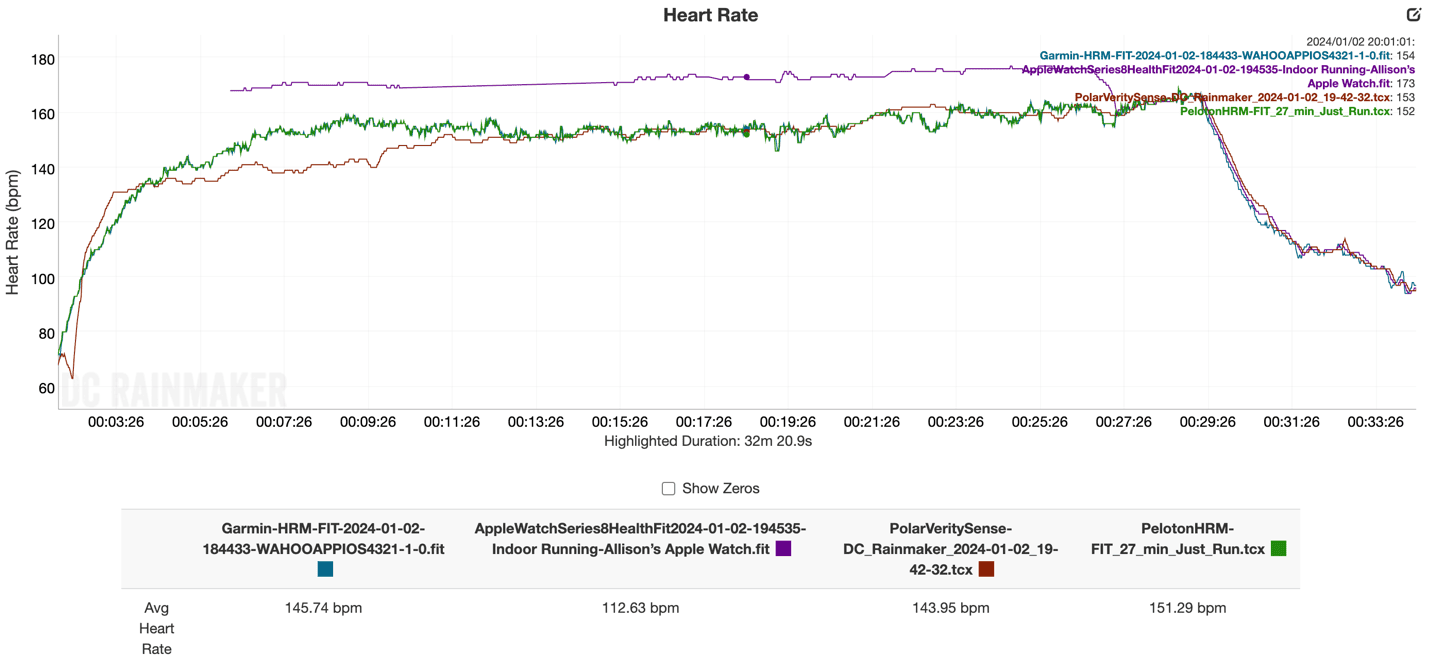
Obviously, the Apple Watch Series 8 was significantly struggling with life here. I found out afterwards her watch has been really having a tough go of it with it frequently dropping HR for no obvious reasons. Meanwhile, on the HRM-FIT and Polar Verity Sense, they disagreed for the first 10 minutes. Knowing her paces/intensity, I’d pretty easily say the HRM-FIT was the correct one here. You can see later in the run around the 27-minute marker, the Apple Watch Series 8 randomly snaps back to reality. It was worn nice and snug, so given this issue and other recent issues, she’ll probably want to get that thing swapped out. Something is definitely wrong with it. But, once it did come back to reality, all three units were in agreement.
Ultimately, from an accuracy standpoint, outside of the one wonky outside run where it was super cold and exposed skin (and likely very dry pretty quickly, thus typical chest strap failure conditions), the others all were what I expected from what is otherwise a chest strap heart rate monitor. I don’t see any issues with movement or such in the HRM-FIT and the clip-attachment system that would impact accuracy, thus everything appears essentially identical to the existing HRM-PRO series of straps from an accuracy standpoint.
(Note: All of the charts in these accuracy portions were created using the DCR Analyzer tool. It allows you to compare power meters/trainers, heart rate, cadence, speed/pace, GPS tracks, and plenty more. You can use it as well for your own gadget comparisons, more details here.)
Wrap-Up:

Ultimately, there are two sides to the HRM-FIT. Starting with the technical side of things, everything worked well here. From the ANT+ & Bluetooth Smart connectivity, to the more advanced download/caching, to the Running Dynamics and Running power metrics pulled from it, as well as equivalent chest strap performance to what I’d normally see on an HRM-PRO Plus series strap. All of that was as expected and without issue.
Likewise, for areas of build quality and whether or not there’s any movement in the strap – that too was spot on. Even in areas like the comfort of the strap, neither of my testers had any issues with it once it was actually clipped on.
However, the bulk of the annoyances with the HRM-FIT were mostly around taking it on/off, in that it seemed like simply unnecessary extra steps/things to do, without any real tangible benefit over either a traditional chest strap, or even an optical armband (which tend to have higher accuracy levels than wrist-based optical HR sensors). Both my wife and my friend said that the HRM-FIT simply didn’t solve any actual problems for them. Instead, it just added more things to deal with, and at a higher cost. However, both noted that there is undoubtedly some other women/use case where it fits the bill for better.
Thus, the good news is that while it didn’t seem to fit either of my small sample size of two testers, if it fits your use case, then go forth – the strap and build quality is solid, as well as all the data connectivity bits you’d normally expect from one of Garmin’s higher-end straps.
With that – thanks for reading!
Found This Post Useful? Support The Site!
Hopefully you found this review/post useful. At the end of the day, I’m an athlete just like you looking for the most detail possible on a new purchase – so my review is written from the standpoint of how I used the device. The reviews generally take a lot of hours to put together, so it’s a fair bit of work (and labor of love). As you probably noticed by looking below, I also take time to answer all the questions posted in the comments – and there’s quite a bit of detail in there as well.
If you're shopping for the Garmin HRM-FIT or any other accessory items, please consider using the affiliate links below! As an Amazon Associate I earn from qualifying purchases. It doesn’t cost you anything extra, but your purchases help support this website a lot.
Here's a few other variants or sibling products that are worth considering:
And of course – you can always sign-up to be a DCR Supporter! That gets you an ad-free DCR, access to the DCR Quarantine Corner video series packed with behind the scenes tidbits...and it also makes you awesome. And being awesome is what it’s all about!
Thanks for reading! And as always, feel free to post comments or questions in the comments section below, I’ll be happy to try and answer them as quickly as possible. And lastly, if you felt this review was useful – I always appreciate feedback in the comments below. Thanks!




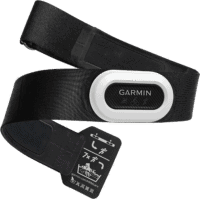



















I think there’s a mistake: “ Now, this is one of the few products I can’t actually test directly.” I think you meant to write “ Now, this is one of the few products I won’t actually test directly.
Was going to say the same. Ray just isn’t as dedicated as he should be ;)
Seems like a neater and more flexible solution to the old Polar version with electrodes built into clothing that had the snaps on to connect the sensor.
Haha…well, while I certainly could have worn a sports bra, I think from an accuracy standpoint, as well as understanding the nuances there – having women test it was much more realistic. :)
Was thinking the same, but then again it would be hard to do comparison as one doesn’t usually wear bra.
Other mistake is that there probably should be mental, not metal in “she noted that was purely a metal thing”.
Ah, took me too long to finish reading this (opened the tab during day and read after workday) and the metal was already fixed and Ray already commented about testing it itself. Should probably have reloaded the page before commenting.
Why can’t brands figure out straps for women? 😩 The last thing I want is more hassle when trying to put a bra and then bib on.
I appreciate they are putting in the effort, and hopefully this is a “get something to market to test interest and then spend real money to develop a unique design”!
PS: at some point you said metal instead of mental ;)
Thanks Arleigh – both for the comments, and also the metal catch!
One other nitpick – I think “ensuring snug fig” should be “ensuring snug fit”
I suppose Garmin could address the HRM-FIT’s downside by developing a sports bra with integrated heart rate monitor that would leverage opportunities for reducing the monitor’s size while eliminating the need to attach and detach the device. Of course, this approach would also introduce complexities in terms of sizing, marketing, sales, maintenance, and reliability of a combined clothing-tech product.
Yeah, we’ve seen a number of companies try that over the years (usually with snap-on pods), including even Victoria’s Secret.
The challenge all of them tend to have is that like anything else clothing-wise, it’s super user-specific. Thus, you need to have a vast array of styles/designs to appeal to everyone and get enough uptake interest-wise in the product – all while concurrently trying to make a technical product that competes against chest straps too (accuracy or features-wise).
It’s one of those things that’s really tough to pull-off business-wise. I think Garmin might roughly be on the right track here business-wise (and certainly tech), but at that price point, neither my testers or I could see the appeal of it compared to existing options from both Garmin and competitors.
Hmm this just seems pointless to me – as you said in the post, my sports bra is already the most constricting thing, i can’t say adding a chest strap has ever felt much different than wearing just the bra (in fact, i typically would use the bra to essentially hold the chest strap in place, I’ve never felt I needed to super tighten the chest strap because I can tuck it under the bra).
At this point I prefer an armband HRM anyway, so this isn’t a product for me.
But I am a little disappointed you didn’t get yourself a bra and try it out yourself!
I’ve never worn a chest strap, and as a bloke, I dont expect I’ll ever wear a bra-based chest strap either. I’ve preferred an optical arm sensor since the days of the Mio.
As you seem to suggest in your review, there is zero reason why someone would just this over an arm-residing optical sensor – especially for buyers of recent watches (assuming anyone actual looks at running dynamics data?!).
Things are obviously different for caching / swimming etc. where an optical band isnt really practical. But that’s a big a big premium for a few clips.
Something you didn’t mention is that, I assume, clipping it to swim bra would mean it wont slip when swimming/turning – but did the HRM Swim solve that issue anyway?
This actually seems like a step backwards, but in a positive direction (if that makes sense!). I much preferred Garmin’s earlier HRMs when the strap was replaceable and the actual HRM just snapped on to it. Now I have several recent Garmin HRMs which have electronics that work just fine, but are unusable because either the elastic has lost its stretch or, more frequently, the plastic around the sensors has split, despite me following all of Garmin’s care instructions and not being one of those people who seem to sweat hydrochloric acid. My most recent purchase was the model with the tool-less battery replacement, which in hindsight was pretty dumb of me as the batteries now seem to outlast the actual straps.
I got two replacements for my HRM Pro already from Garmin. It was absolutely hassle free. Call, tell them it’s Brocken, get a replacement.
2023 they send me the HRM Pro Plus because they don’t have the Pro anymore.
This looks like a chafing nightmare. I went back to the old version of the garmin HR strap (not the clip on) and think it works best of all. Would love it if the wrist HR actually worked, but too unpredictable.
As someone who has to wear a chest strap in colder weather (since my Garmin watch thinks my cadence is my heart rate when my arms get cold), and doesn’t like the double constriction feeling of both a bra and a strap, I am so looking forward to using this!
Your two testers looked like they had small to average cut sizes and relatively soft bras even though intended as medium to high impact. My wife at a 30G would probably appreciate this a lot more as the industrial engineering needed for a high impact bra means a much stiffer band and often an underwire that can interfere with a traditional strap (which she usually wore fairly loose and had to stuff under the band putting pressure on the pod or they were too low to register). Having a thin band under the bra strap and the pod outside is likely to be much more comfortable and avoid the pod migrating down.
I am in a similar situation as your wife. Even with an under-wire high impact sports bra, I still have a bit of movement. I wonder if that movement would cause issues with the strap?
While I’d die for your wife’s figure being a 30G with an underwired sports bra is a whole different concept, the sports bras in the review are what I’d call light support!
Chest straps with my boobs and sports bra are nothing short of uncomfortable and annoying however not sure this will clip onto the narrow band of my sports bra either and the wires might get in the way. Def not sure enough to agree to commit the asking price of it..
I’m in the market for a HRM so I don’t have to wear my swim one for running and bike, if this is Garmin’s best effort for a female friendly version I might have to give into the arm band instead.
What I’ve realised on this one too is the bulk of the pod electronics still sit under your bra strap which is probably as uncomfortable as tucking in an existing band. If they’d put the electronics of the outside of the hinged piece and run a sturdy fabric electrical connection around the hinge that would be so much better.
I’m also a 32G and wear exclusively underwire sports bras rather than these flimsy compression bras that I see on every review. I have the eternal problem that I can’t put a chest strap under my bra because that elevates the wires in a weird uncomfortable way and if I put it below the bra it has some chance of sliding down off my chest into my belly where it stops reading. If I tighten it to try to get around this it really restricts my breathing. This clip looks like a godsend if it actually fits on underwire bras, but unfortunately all the reviews I can find online (including this one!) only test it on soft bras, totally useless to me.
Has your wife tried this strap with her underwire bras? I’d be really interested to know if it works before I drop $150 on it.
I was wat ching the video, when noticed the lily 2 in one of the comparisons, first I thought thats a mistake, then made a quxik search and found it was announced today also, I guess there will be a review in the upcoming days.
The main reason that I stopped using a chest heart rate monitor was due to the interaction it had with my bra. The bra would push it down, or land right on it causing it to push the puck into my chest, it would create additional chafe points, or generally it would feel like it wasn’t positioned correctly since I had to work with it around my bra. I would like to use a chest strap to get more accurate Heart Rate zones (I know that there’s at least one feature on my Fenix 6 that requires me to use a chest strap and I would like to use that) but I can’t justify getting one due to the annoying interaction with the bra. I was hoping that this would help that situation, but I can’t tell from your review if it would.
Personally, I put my HRM in the TOP part of my sports bra – it’s held in place by the straps of my bra and my breasts. I still use the very old hard-plastic only-ANT+ Garmin monitor, but once my stash of those finally dies I’m planning to just cut off the sides of the new flexible ones and continue doing this. I don’t see the reason for this clip-on thingy, and I never liked having my HRM around my rib cage because it always chafed and I had too much pressure. All the HRM needs is contact with the skin – there’s nothing magical about being around the ribs vs on top – although I suppose if you’re smaller-breasted then maybe the strap wouldn’t be held in place as well.
ProTip: a cone wrench will also open a battery compartment if you don’t have a coin handy.
I wonder if the reason for crazy high prices for the high-end chest strips is the fact that most casual athletes just use their watches today and skip the separate HRM?
Personally I stopped using the HRM for running (except for interval work) and outdoor cycling. Still use it on the bike trainer though.
I’m so excited to try this! This product would solve two problems for me:
1) I find when wearing a chest strap and a high impact bra, especially during high intensity cardio, the double compressive effect gives me side splints more often. (I have scar tissue in my lower intercostals from a previous illness)
2) During combat sports where I can’t wear a watch or arm band, the chest strap falls down every time by the end of a good sparring session.
Thank you for another great and greatly detailed review
I am quite surprised that you got clearance for the first picture in the USAGE AND TEST FEEDBACK section, since it is not the most flattering picture ^^
Why are you commenting on how she looks in a photo? Yikes.
Generally speaking, when my wife is knocking out a workout, it’s all business.
I pulled that one from video, rather than direct stills – and eventually, I gave up on trying to find the perfect frame where her facial expression was as nailed as what the rest of her body was doing/looking like.
Just like when anyone freezes a video at random points and people have weird expressions/etc, that’s even more true on a largely exposed body while running at speed. Finding the 1/30th of a second moment where all those things happens perfectly is tricky. I might try again later.
Just for clarity, my comment wasn’t meant to be on her looks, but on the picture. Photography is not reality, but it can easily make somebody look good / bad. Even more understandable when it is taken from a video.
Nevertheless, I do understand that it can be read differently. If somebody feels offended by it, please ignore it.
Interesting that the hr on the FIT drops to ~70bpm after ~5 mins during the run. I am having this exact issue with 955 and hrmpro+ since 17.24/6 software update. Garmin replaced the strap but the issue remains so I’m wondering if it isn’t actually strap related.
IMO the issue with traditional HR straps is I either have to stuff it inside the sports bra (which doesn’t really have room because it’s a high-impact one and not crop-top length) OR to have it float underneath my sports bra, which is when they feel like slipping. I haven’t tried this one yet, but I’m excited that at least something finally exists (happy 2024!) and it could be solving that latter problem.
PS @DCR: it’s “chafing”, not “chaffing”
*I more meant float “below” rather than “underneath” sportsbra. Further down my chest.
This feels like another example of the pink tax to me – slap “for women” on it and add a price markup. This would actually be LESS functional for me than a regular heart rate strap, because it won’t attach to my one piece swimsuits.
While I think there are plenty of pink taxes out there, this honestly just seems to me more like a typical Garmin Tax, in terms of premium pricing that’s sometimes out of whack with the market. We’ve seen it more lately on a few products (thinking some of their Tacx ones), as well as even many of the bands/straps for watches.
But yes, for one-piece swimsuits, this is definitely less functional.
Thank You for your review. My bra band size is 28 and my chest measurement is 26″. Once my HR monitor bands stretch they slide down on me. I consistently have to tighten the bands by using safety pins to shorten them. This type of strap is an ideal solution for me. I’m thinking of trying it but have concerns that it still may be too wide for me. I’m thinking I won’t have the slipping problem but will the electrode placement be too far behind my rib cage or does that matter?
In theory it shouldn’t matter too much – as some people can even wear a chest strap on their back with moderate success.
That said, this is actually a bit smaller (inwards) electrode pads than the HRM-PRO series, about 1cm or so for each pad. There’s a brief shot of that in the video in the first couple minutes, maybe I’ll take a photo of it and stick it in the review.
For the Polar H10 there is a XS-S (58-71 cm) strap available. If you are looking for heart rate only without advanced running metrics, this might be an option at a lower price point
Thank You. I found this strap on Amazon.
link to amazon.com
My Wahoo sensor fits the holes perfectly. I have approximately 7″ of strap to adjust as the strap stretches. I haven’t worked out with it yet but it feels very comfortable. The strap is softer and slightly more stretchy than the Wahoo strap. It comes in different colors. For $6.99 this is worth a try.
Thank you for reviewing this product! I avoid chest-strap heart rate monitors whenever possible because they tend to slip or chafe; having a really in-depth review of this new option, with a focus on the practicalities, is very helpful. Kudos to your wife and friend for their testing feedback! (Including winter running in summer gear, that’s dedication!)
Maybe a bit off topic – speaking of “running power” I wish that Garmin would offer / expose the Running Power fields on other Activities like Walk, Hike, not just the Run based activities. When Hiking, Walking, it can be nice to know some of the Run Dynamics information. So one has to copy them from Run or Trail Run, and call them Hike or Walk.
Décathlon used to sell bras (and running t-shirts for men) with an integrated strap on which you would clip the pod. Worked very well, it was far more convenient than a separate strap which I find would always slide down at some point in time. And it was much cheaper than Garmin’s solution.
Unfortunately, they long discontinued that product.
I know, it is more pricey from hrm-pro plus. But also, they have a durability problem, and could HRM-Fit be a solution to that problem? And could it replace HRM-Pro plus on next generation products? Or could it be used by men with an ordinary textile strap? I’m using pro plus and first One went to warranty at 9th month and replaced under warranty.
What’s most interesting to me (as a possessor of moobs more than boobs) is that this is on sale in AU/NZ. The key here is that the battery compartment meets the safety rules down here that has prevented the HRM-Pro plus being on sale, leaving us with the green HRM-Pro where there is a 50:50 chance of killing the strap when changing batteries. So I’m hopeful that this means that soon there will be a HRM-Pro-Plus-Update which will be onsale globally.
Plus one to the thought that this HR strap falls into the Pink Tax category!
I am outraged that they charge more for this women’s product than they do for their regular premium strap. I think it’s great that it is designed by women, and that there is work being done to make women comfortable while working out! But the extra cost feels like a slap in the face. Men would not pay extra for something made specifically for men, would they?
Garmin does not get a pass from me on this, whether it is because they’re just bad at pricing things, or we can blame it on “Garmin Tax.” Why isn’t their other premium strap just as expensive, then?
For those who work in healthcare settings with the irritating and poorly-evidenced ‘bare below the elbows’ policy, would this work instead of wearing the Forerunner 255 to capture reliable data? Thank you
Yes, for heart rate data. It’ll sync with your Garmin Connect account and pull in:
– Gaps in your heart rate timeline (throughout day)
– Calories
– Steps
– Intensity minutes
It connects to your phone for that sync portion.
Amazing, that’s really helpful. It is expensive but it might solve the problem. I hate not wearing my Forerunner :-(
Thank you for such a clear and quick response!
Neither of the women who tested it for you are wearing proper sports bras, they’re just wearing crop tops. I’d be curious to see how it feels for someone with larger breasts (D+) who needs to wear a proper sports bra. I think it will be really useful for me as I find it difficult to get the HRM strap to sit flush under my bra strap without bits digging in/folding up. I think this could solve that. Less keen to pay a premium for that though.
Really helpful review. I’d been contemplating one but since garmin haven’t bothered to reply have turned attention to polar products ! :) thank you great site
Returning mine. Does not lay flat and very inaccurate readings. I have tried several different bras and none seem to hold it in place. I also tried ultrasound gel to see if that would register vs saliva. I have been using HR for 30+ years so I have tried them all.
Does the monitor track hill score? I would love this feature without having to update my fenix 6
No, Hill Score requires the newer Garmin devices, but specifically, on the watch side (since it’s all about altitude gain).
Thank you for the response!
Hi Bobbie, Ray,
Any idea if it is feasible to wear the Hrmfit for an extended time, approx 12 to 13 hour stretch?
I’m talking about health care setting where watches/jewellery are not allowed due to infection control.
Many thanks
Eamon
Hi!
Hope you are well! Thanks for the great review of the HRM Fit. i have watched your video and read your vlog before purchasing and it was a great source of information. I purchased the HRM Fit as I play Basketball and am not able to wear my Garmin watch while playing but am interesting in my pace, distance and HR while playing. Although when i played this week it did not measure my pace and distance, only my HR. I started an indoor track workout before the game and the settings on the HRM the “use for pace and distance” was on indoor and the Auto Calibrate was On. I know in you video you tested it on the treadmill without wearing the watch and was able to get distance and pace data. Is there something I am doing wrong :( I would really appreciate your help! I have read so many different forums some saying you can and some saying you can’t! :) If anyone can help that would be amazing! Thanks, Madi
This heart rate monitor target audience is probably for people like me with a small chest size. Regular Garmin straps don’t get small enough and have to bunch them under your bra strap. Wahoo sizing is a little better.